12 Simple Steps To Leash Train Your Cat
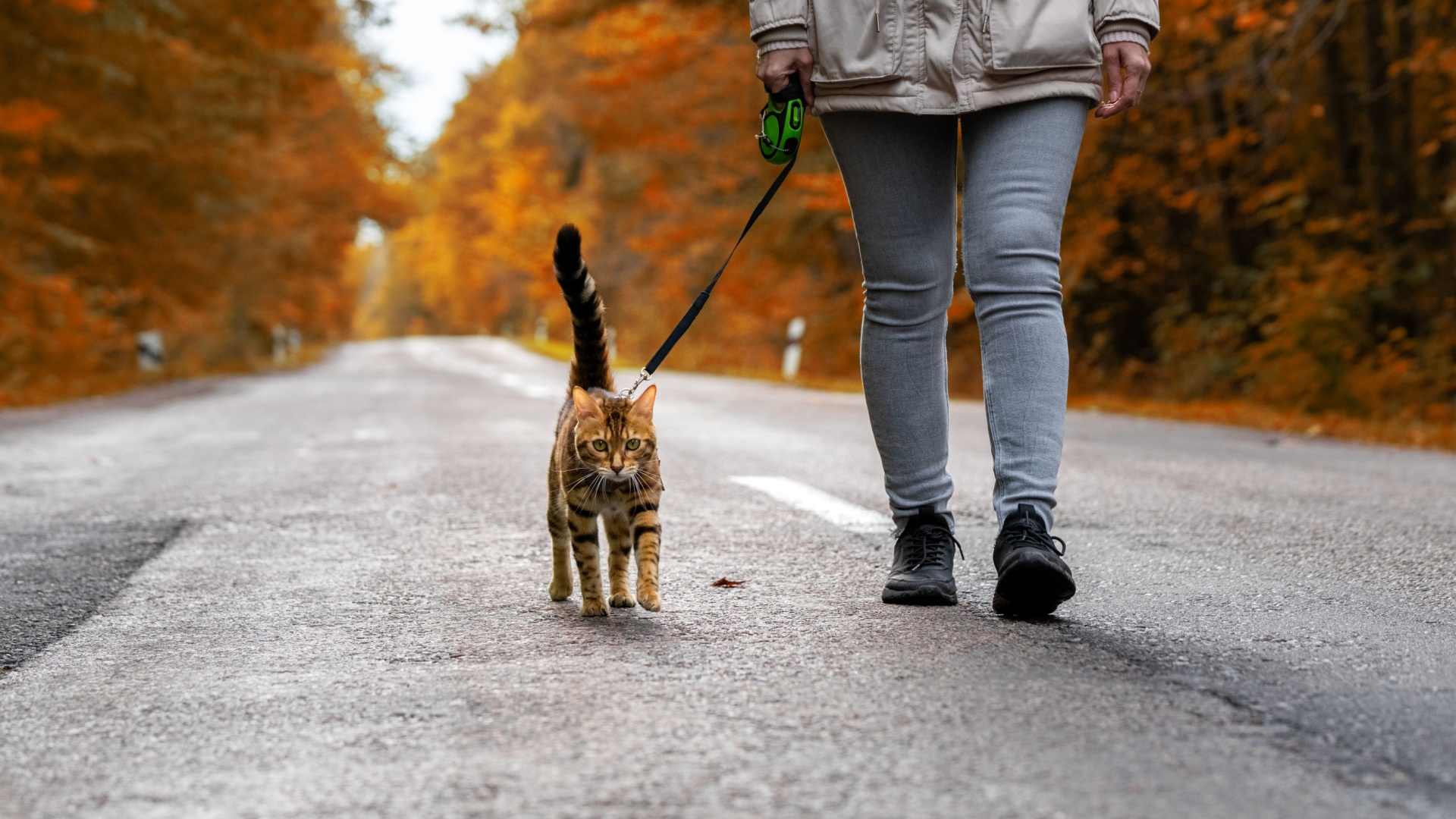
Leash training a cat might seem like trying to teach a fish to ride a bicycle, but with a sprinkle of patience and a dash of know-how, it can be a fun adventure for both you and your feline friend.
If you’re dreaming of leisurely strolls in the park with your whiskered companion, fear not! Each of these steps is crafted with a mix of humor and practical advice to ensure both you and your cat have a purr-fectly enjoyable experience.
Get ready to embark on a journey that will have your cat strutting their stuff on a leash in no time.
1. Choose The Right Harness
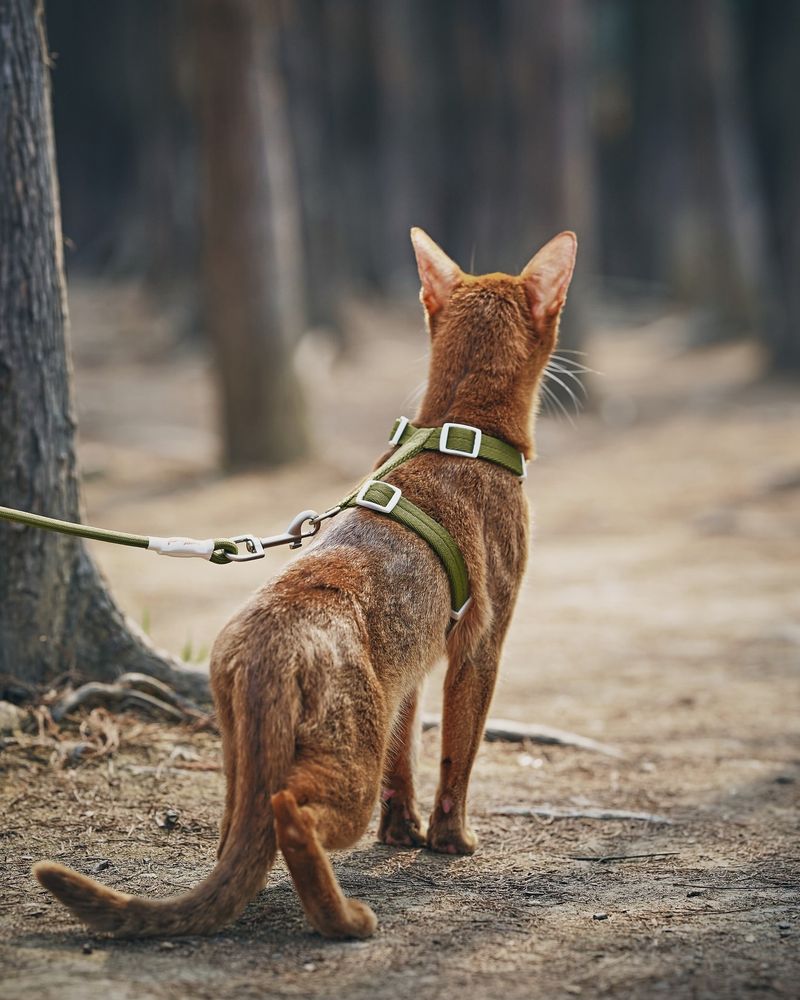
When it comes to leash training your cat, the first step is selecting the perfect harness. Think of it as finding the right pair of shoes – comfort is key! The harness should fit snugly but not too tight, allowing your cat to breathe and move freely. Look for a design that’s adjustable and made from soft materials that won’t irritate your cat’s skin.
It’s like choosing between a cozy sweater and an itchy wool sweater; you’ll want the former. Once you’ve selected a harness, let your cat get acquainted with it. Leave it in their favorite lounging spot or next to their food bowl. This way, the harness becomes part of their daily scenery, reducing any initial resistance.
Patience is vital here, as forcing the harness on your cat too soon might backfire. Remember, slow and steady wins the race, or in this case, the cat’s trust! Finally, reward your feline friend with treats or extra cuddles every time they show interest in the harness.
Positive reinforcement makes the process smoother and more enjoyable for both of you. After all, who doesn’t work better when there’s a treat at the end of the tunnel?
2. Introduce The Harness Gradually
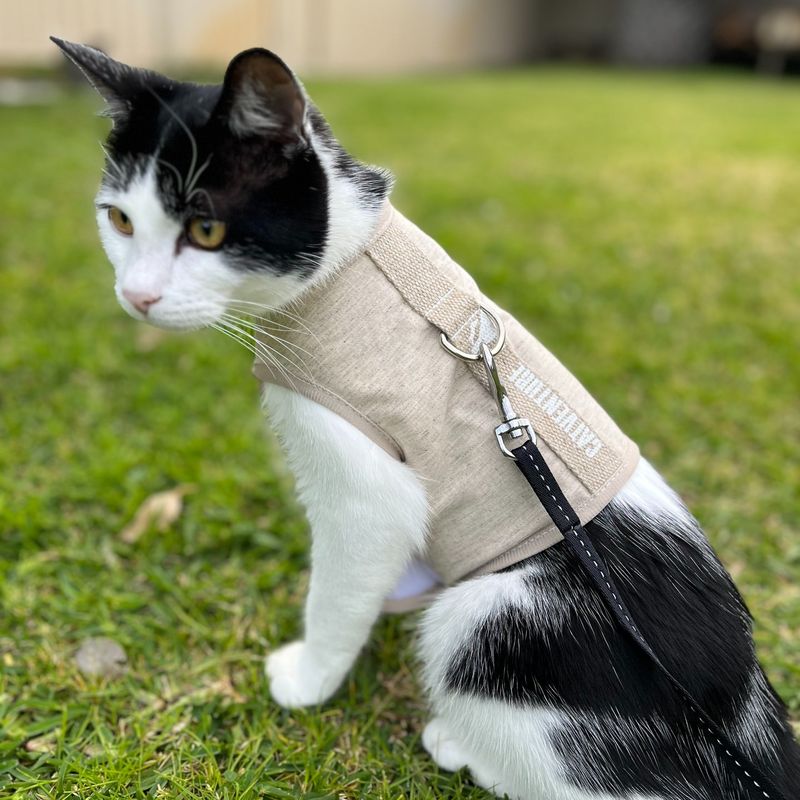
Introducing the harness to your cat is all about subtlety and strategy. Lay the harness on the floor and let your cat explore it at their own pace. Cats are naturally curious creatures, and this new addition to their environment will likely pique their interest. Use treats to encourage your cat to come closer and investigate the harness. Think of it as a feline treasure hunt, with the harness being the ultimate prize at the end.
During this introduction phase, keep the harness within your cat’s daily routine. Whether it’s playtime or feeding time, having the harness nearby helps your cat associate it with positive experiences. This can significantly reduce anxiety and resistance when it’s time to put it on. Avoid rushing this step. Some cats may take to the harness immediately, while others might need a little more time.
Be patient and let your cat’s comfort level guide the pace. Providing consistent positive reinforcement with treats or praise whenever they interact with the harness will make this phase both rewarding and enjoyable for both of you.
3. Practice Indoors First

Before venturing into the great outdoors, allow your cat to wear the harness indoors. This is like a dress rehearsal before the big show. Start by gently placing the harness on your cat, ensuring it’s secure but comfortable. Watch as they strut around the living room, potentially with a hint of dramatic flair. Keep the first indoor session short – around 5 to 10 minutes. This ensures your cat becomes accustomed to the new sensation without feeling overwhelmed.
Gradually increase the duration over several days. Meanwhile, engage your cat in play with their favorite toys. This distraction helps them associate the harness with fun times rather than confinement. As you repeat these indoor sessions, observe your cat’s behavior. Look for signs of discomfort or distress, and adjust as necessary.
This gentle introduction helps your cat build confidence while wearing the harness, setting the stage for a smooth transition to the next step of leash training.
4. Attach The Leash
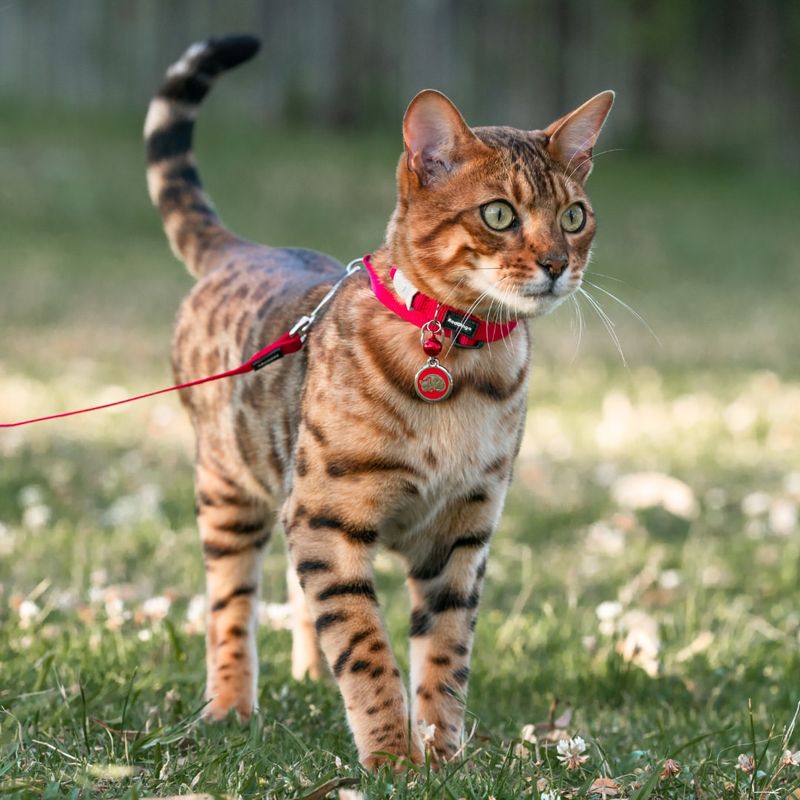
Once your cat is comfortable with the harness, it’s time to introduce the leash. Think of this as adding the cherry on top of a sundae. Attach the leash while your cat is indoors and allow them to drag it around for a short period. This gives them a feel of having something trailing behind without the pressure of being pulled.
Make sure to supervise your cat during this stage to prevent any mishaps or tangling. The goal is for your cat to become accustomed to the sensation of the leash and understand that it’s not a threat. You might notice them glancing back at the leash as if saying, “What’s this new tail I’ve got?” Let them explore and satisfy their curiosity. Gradually, start holding the leash and gently guiding your cat a few steps at a time.
Remember, you’re not walking the cat just yet – simply familiarizing them with the concept of a leash. Keep it light-hearted and fun, offering treats and praise for their bravery and cooperation.
5. Introduce Basic Commands

Introducing basic commands to your cat while on the leash is like teaching them the ABCs of outdoor adventures. Start with simple commands such as “come here” or “stop.” Use clear, consistent language and gestures. For instance, use a treat to guide your cat towards you while saying “come here,” and reward them when they follow through.
Incorporate these commands into your indoor play sessions. This not only helps your cat learn the commands but also strengthens the bond between you two. Be patient; cats are not as quick to obey commands as dogs, so persistence and positive reinforcement are crucial. Make each training session short and sweet to keep your cat engaged.
Gradually, your cat will begin to understand the commands and respond accordingly. This foundational training will be instrumental once you venture outside, ensuring your cat remains safe and within reach during your outdoor escapades.
6. Choose A Quiet Outdoor Space

Selecting the perfect location for your cat’s first outdoor adventure is akin to choosing the right venue for a debut concert. Look for a quiet, safe space, free from loud noises and distractions, such as a private garden or a secluded part of a park. This setting will allow your cat to explore without feeling overwhelmed by the hustle and bustle of busy areas.
Before heading out, check the area for potential hazards such as toxic plants, busy roads, or aggressive animals. Safety first! Remember, this outing is to build confidence, not create a stressful experience. Your cat’s first impression of the outdoors can set the tone for future adventures. Once you arrive, allow your cat to take in the sights and sounds at their own pace.
Keep the leash loose, giving them the freedom to explore while still ensuring they’re under your supervision. This initial outdoor session is about familiarization and comfort rather than covering distance.
7. Let Your Cat Lead
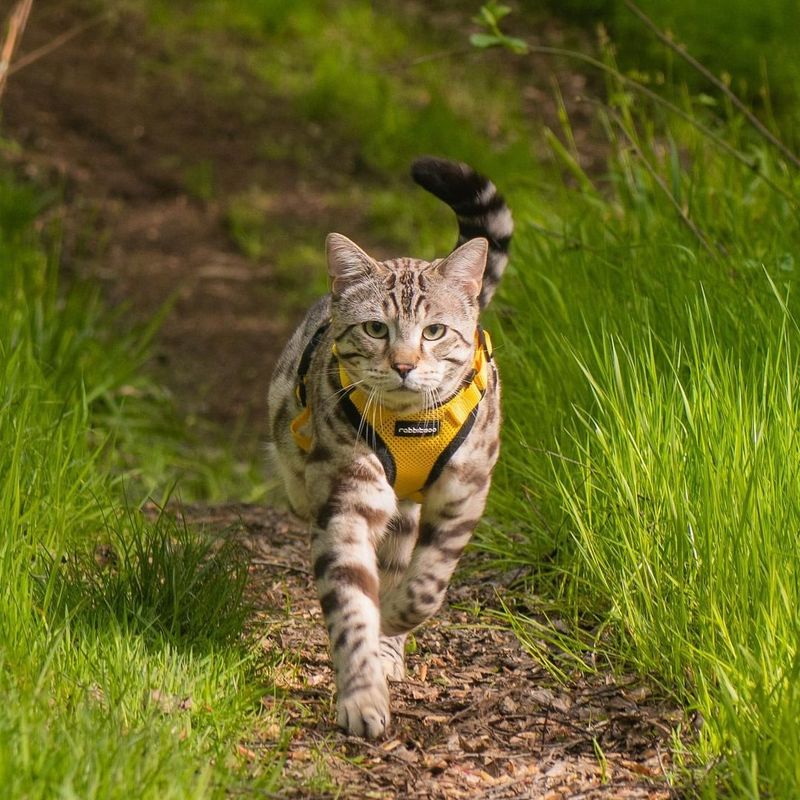
Imagine your cat as the captain of this outdoor journey, guiding you through their newfound world. Allow your cat to lead the way, choosing where to go and what to sniff. This autonomy in a controlled environment helps build their confidence and sense of security.
Keep a relaxed grip on the leash, allowing it to stay loose. This shows your cat that they’re still in control while you provide support. Avoid tugging or pulling on the leash, as this might cause fear or resistance. Encourage exploration by praising your cat’s curiosity and bravery.
A little positive reinforcement goes a long way in making your cat feel like the intrepid explorer they truly are. By letting your cat lead, you’re ensuring a pleasant experience that can foster a love of the outdoors.
8. Gradually Increase Outdoor Time
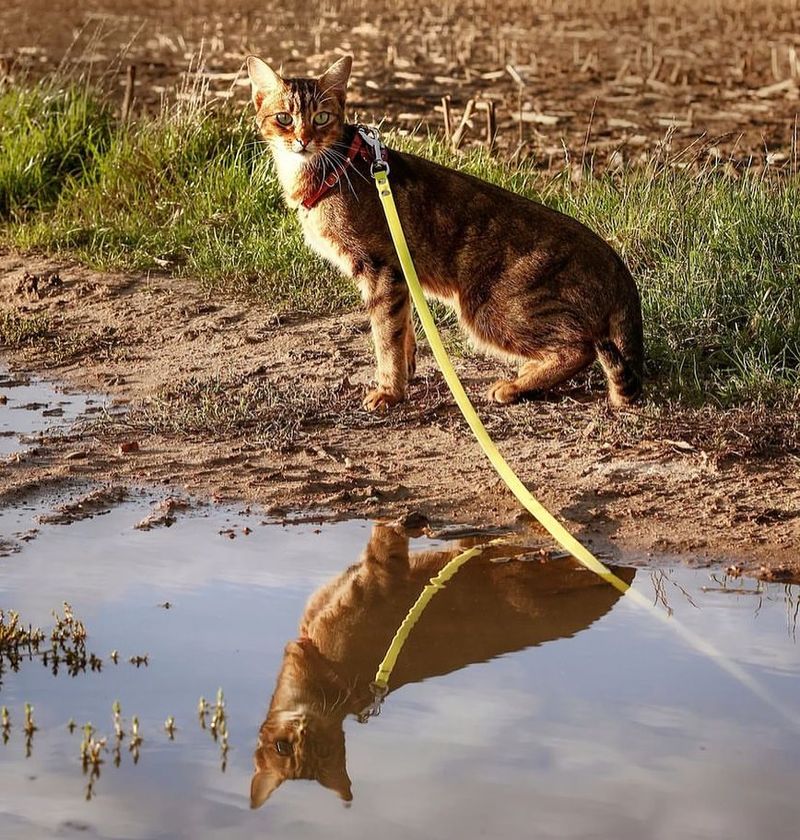
Building your cat’s outdoor stamina is similar to training for a marathon – start small and gradually increase the duration of your excursions. Begin with short sessions lasting around 5 to 10 minutes, slowly extending the time as your cat becomes more comfortable and confident. Monitor your cat’s body language to gauge their comfort level.
Signs of relaxation, such as purring or lying down, indicate they’re enjoying the outdoors. On the other hand, if your cat is tense or agitated, it might be time to head back inside. Each session should end on a positive note, leaving your cat eager for the next adventure.
With patience and consistency, your cat will soon look forward to their outdoor escapades, and you’ll both enjoy the shared experience of exploring the world together.
9. Be Aware Of Environmental Factors
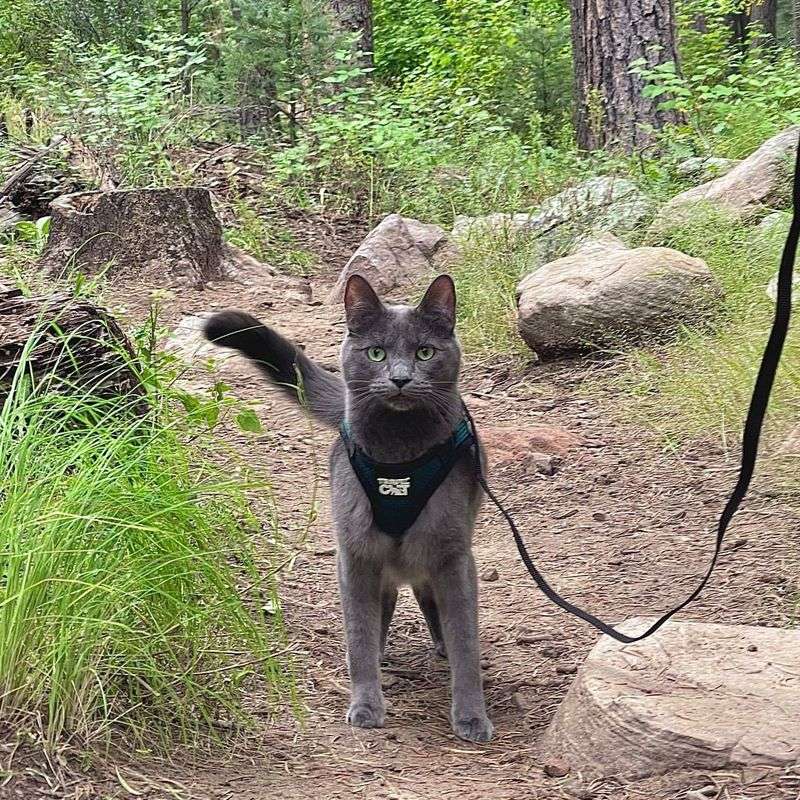
When exploring the great outdoors, being mindful of environmental factors is akin to checking the weather before a picnic. Be aware of the weather conditions, temperature, and potential hazards in the area. Avoid walking your cat during extreme temperatures or in harsh weather such as rain or snow.
Keep an eye out for other animals or distractions that might pose a risk to your cat. While curiosity is a cat’s nature, safety is paramount. Be ready to gently redirect your cat’s attention if they become fixated on something potentially dangerous. Having a keen awareness of the environment ensures that each outdoor session remains safe and enjoyable.
This mindfulness allows you to anticipate and mitigate any potential challenges, ensuring your cat’s outdoor experiences are as delightful and carefree as possible.
10. Encourage Exploration And Curiosity

Encouraging your cat to explore their surroundings is like opening the door to a new adventure. Allow them to sniff, paw, and observe their environment, indulging their natural curiosity. This exploration helps satisfy their instinctual need to assess and understand their territory. Be patient and give your cat the freedom to investigate different textures, scents, and sights.
This freedom of exploration is crucial in making the outdoor adventure enriching and fulfilling. Remember, the journey is more important than the destination. Praise your cat for their exploration efforts, reinforcing their confidence.
Each new discovery is a step towards a more adventurous and well-rounded kitty. By nurturing their curiosity, you’re fostering a love for the outdoors that will make leash training a truly rewarding experience.
11. Provide Treats And Positive Reinforcement
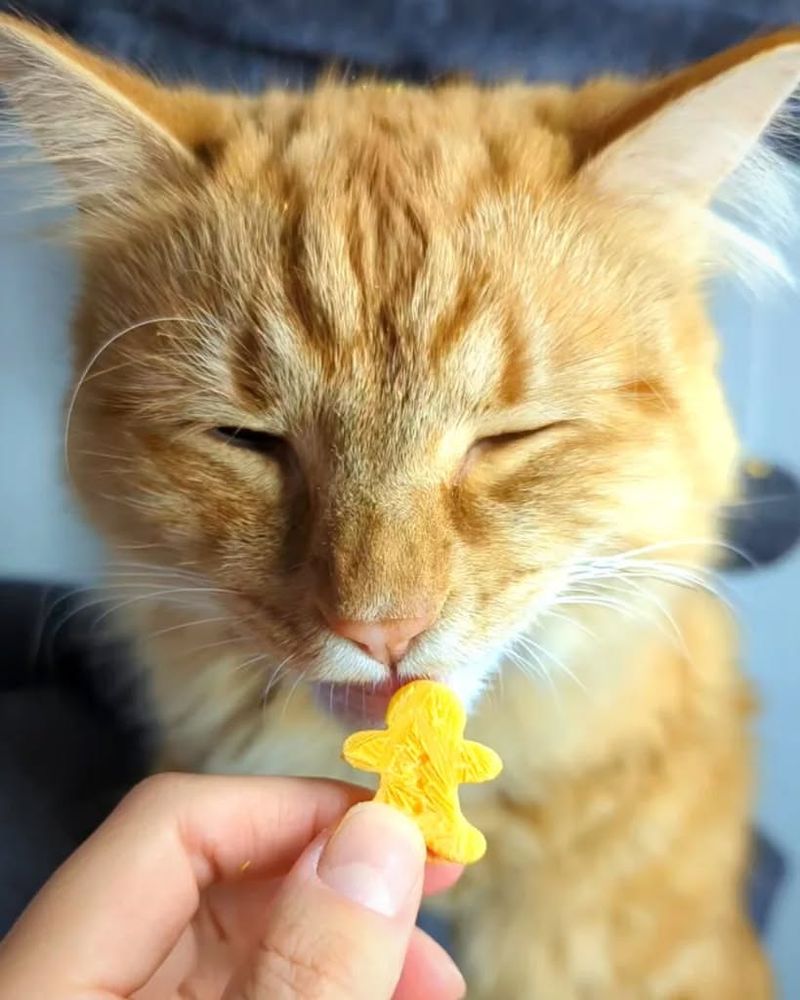
Treats and praise are your best allies when it comes to successful leash training. Think of them as the secret sauce that makes the whole experience delightful. Reward your cat for wearing the harness, walking on the leash, and exploring outdoors.
Positive reinforcement not only makes the process enjoyable but also strengthens the bond between you and your cat. Offer treats that your cat loves, ensuring they’re small enough to be given frequently. This constant reward system helps your cat associate the leash and outdoor experiences with positive emotions.
A happy cat is more likely to be cooperative and eager for future adventures. Besides treats, use verbal praise and gentle petting to show your appreciation for their bravery and cooperation.
This combination of treats and affection creates a positive feedback loop, making leash training a fun and rewarding activity for your feline friend.
12. Stay Patient And Consistent

Patience and consistency are the cornerstones of successful leash training. Imagine them as the steady drumbeat that keeps everything in harmony. Every cat is unique, and their journey to becoming comfortable on a leash will vary. Some may take to it quickly, while others need more time to adjust.
Consistency in your training routine helps build familiarity and confidence in your cat. Sticking to a regular schedule of short, positive sessions ensures that your cat knows what to expect and becomes more comfortable over time. As with any learning process, there may be setbacks, but remain patient. Celebrate small victories and progress, no matter how minor they seem.
This approach not only makes the training enjoyable but also strengthens the trust and bond between you and your furry friend. With patience and consistency, leash training can become a fulfilling experience for both of you.






